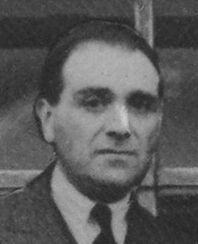
Summary
Arthur Felix, FRS[1] (3 April 1887 in Andrychów – 17 January 1956 in England) was a Polish-born microbiologist and serologist.[2][3]
Arthur Felix | |
|---|---|
 | |
| Born | 3 April 1887 |
| Died | 17 January 1956 (aged 68) |
| Known for | Weil–Felix test |
| Awards | Fellow of the Royal Society[1] |
| Scientific career | |
| Fields | Microbiology |
| Institutions | Lister Institute |
Education and early life edit
Arthur Felix was the son of Theodor Felix, who had an interest in printed textiles and who encouraged his son to study textile dye chemistry. Felix studied chemistry in Vienna and was awarded a Doctor of Science degree. After working in his father's textile printing factory, he returned to Vienna to study microbiology.[1] Arthus Felix was Jewish;[4] he became interested in Zionism during his student days in Vienna and later developed into an authority on Palestine.[5]
Career edit
In 1915, Arthur Felix and Edmund Weil were Austrian medical officers working in a field laboratory in Sokal and discovered a diagnostic test for patients with typhus that makes use of an antibody cross reaction to a strain of Proteus bacillus that had been isolated from urine.[6] They developed the Weil–Felix test for diagnosis of typhus and other rickettsial diseases.[7] The use of the O and H symbols in the Kauffman–White classification originates from the research by Edmund Weil and Arthur Felix.
In 1934, Felix identified the Vi antigen in patients with typhoid fever.[8] The discovery of Vi antigen was done in collaboration with Miss R. Margaret Pitt.[1] Pitt co-authored many publications with Felix throughout her career, although not much is known about her as misogyny kept her from the proper recognition she deserved as a scientist.[9][10][11]
Felix and Pitt isolated the Salmonella Typhi strain Ty2, which is still in use in laboratory research today.[1] Ty2 was the basis for the Ty21a vaccine strain, a live attenuated strain used to protect patients from typhoid fever today. Ty2 was isolated from a patient in Kherson in 1918.[1] Ty2 was investigated due to its ability to avoid agglutination in rabbit serum, which Felix and Pitt later determined was due to the production of Vi capsule which inhibits binding of O antigen.[9] He and Pitt also then went on to discover antigens present in Paratyphi A and B.[1] He also co-authored a comprehensive review of what was known about typhoid fever and diagnosis with another female scientist, Miss M. Rhodes.[12][13]
Much of the foundational knowledge about typhoid fever pathology, diagnosis of typhoid fever, and the foundational work that lead to the two typhoid vaccines in use today are contributed by Dr. Felix and his colleagues.
After World War I, Felix emigrated to Britain[14] and worked at the Lister Institute.
Felix researched in Bielsko, Vienna, Prague, and London. Between 1927 and 1945, he worked in Jerusalem for the Hadassah Medical Organization.
Awards and honours edit
In 1943 he was elected a Fellow of the Royal Society.[1]
References edit
- ^ a b c d e f g h Craigie, J. (1957). "Arthur Felix 1887-1956". Biographical Memoirs of Fellows of the Royal Society. 3: 52–79. doi:10.1098/rsbm.1957.0005. JSTOR 769352.
- ^ Wilson, G. S. (1957). "Arthur Felix. 3rd April 1887-44th January 1956". The Journal of Pathology and Bacteriology. 73: 281–295. doi:10.1002/path.1700730136.
- ^ "Obituary: Dr Arthur Felix, F.R.S". The Journal of Hygiene. 54 (1): 152. March 1956. doi:10.1017/s0022172400044399. PMC 2218004.
- ^ William D. Rubinstein, Michael Jolles, Hilary L. Rubinstein, The Palgrave Dictionary of Anglo-Jewish History, Palgrave Macmillan (2011), p. 273
- ^ Farr, Alfred Derek (1978). Founders of medical laboratory science. Institute of Medical Laboratory Sciences. pp. 39–40. ISBN 978-0-9506242-0-4.
- ^ Weindling, Paul (2000). Epidemics and Genocide in Eastern Europe, 1890-1945. OUP Oxford. p. 86. ISBN 9780191542633. Retrieved 1 May 2018.
- ^ Brade, Helmut, ed. (1999). Endotoxin in Health and Disease. CRC Press. p. 11. ISBN 9780824719449. Retrieved 23 January 2014.
- ^ Barer, Michael R.; Irving, Will L. (2018). Medical Microbiology: A Guide to Microbial Infections. Elsevier. p. 192. ISBN 9780702071980. Retrieved 1 May 2018.
- ^ a b "A new antigen of B. typhosus. Its relation to virulence and to active and passive immunisation". Lancet. ii: 186–191. doi:10.1016/S0140-6736(00)44360-6.
- ^ Felix, A.; Pitt, R. Margaret (1951). "The pathogenic and immunogenic activities of Salmonella typhi in relation to its antigenic constituents". Journal of Hygiene. 49 (1): 92–110. doi:10.1017/s0022172400015394. PMC 2234993. PMID 20475842.
- ^ Lister Institute of Preventative Medicine (1935). "Report of the Governing Body" (PDF). Archived (PDF) from the original on 12 April 2021.
- ^ Felix, A.; Rhodes, M. (1931). "Serological Varieties of Typhus Fever". Journal of Hygiene. 31 (2): 225–246. doi:10.1017/S0022172400010780. PMC 2170603. PMID 20475090.
- ^ Wilson, G. S. (1957). "Arthur Felix. 3rd April 1887–44th January 1956". The Journal of Pathology and Bacteriology. 73 (1): 281–295. doi:10.1002/path.1700730136. ISSN 1555-2039.
- ^ Brenner, Michael; Liedtke, Rainer; Rechter, David (1999). Two nations: British and German Jews in comparative perspective. Mohr Siebeck. p. 403. ISBN 978-3-16-147106-3. Retrieved 23 January 2014.


